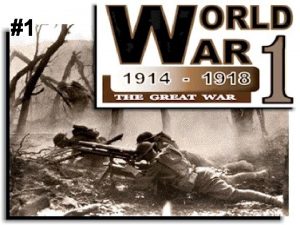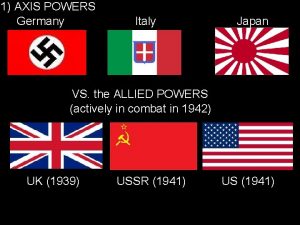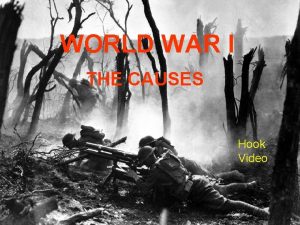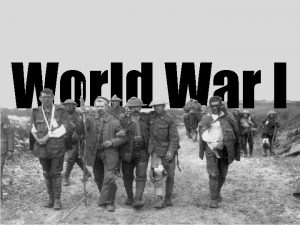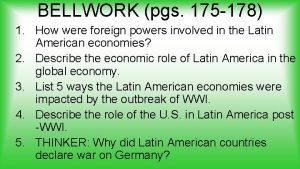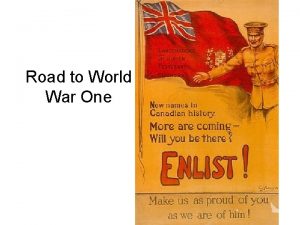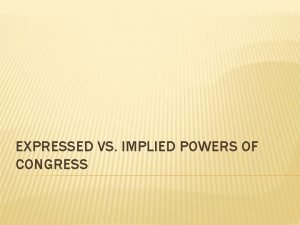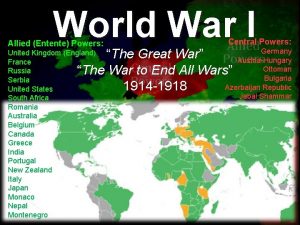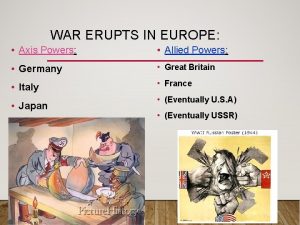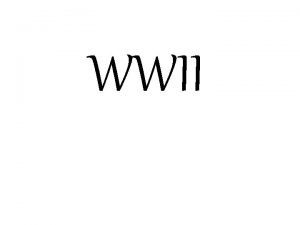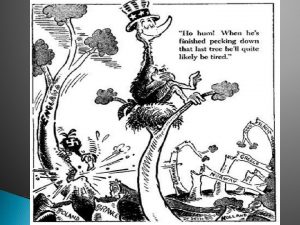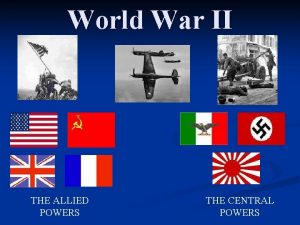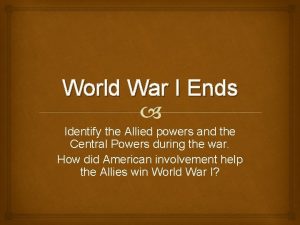World War II The European War Allied Powers














- Slides: 14

World War II (The European War) Allied Powers • France • Great Britain Axis Powers • Germany • Italy

World War II (The European War) After World War I, borders changed, the Austro-Hungarian Empire was broken up, and a number of new countries emerged in Europe. • Finland • Estonia • Latvia • Lithuania • Poland • Czechoslovakia • Austria • Hungary • Yugoslavia

World War II Germany Rises Again 1919: Treaty of Versailles • Germany is forced to give territory to France, Belgium, and Poland. • East Prussia is separated from the rest of Germany. • Germany cannot militarize the Rhineland. • Army limited to 100, 000; conscription forbidden; air force and navy disbanded (land lost in black)

World War II Germany Rises Again 1933: Hitler is named Chancellor of Germany leaves League of Nations. 1935: Germany reestablishes military conscription in violation of Treaty of Versailles. Adolf Hitler Manpower in European Armies 1933 1934 1935 1936 1937 1938 UK 195, 000 196, 000 192, 000 190, 000 212, 300 France 558, 000 551, 000 643, 000 693, 000 698, 000 Germany 103, 000 240, 000 480, 000 520, 000 550, 000 720, 000 Italy 285, 000 282, 000 1, 300, 000 343, 000 370, 000 373, 000 Soviet Union 535, 000 940, 000 1, 300, 000 1, 400, 000 1, 500, 000 Mearsheimer 2001, 317

World War II 1935: Italy invades Ethiopia. 1936: Germany and Italy form Rome-Berlin Axis. Italy intervenes in the Spanish Civil War 1937: Italy leaves League of Nations 1939: Italy annexes Albania 1940: Italy invades Egypt and Greece 1941: Italy declares war on the Soviet Union “In summary, Mussolini, like Italy’s liberal leaders before him, was a relentless expansionist” (Mearsheimer 2001, 209) Benito Mussolini

World War II Germany Rises Again March 1936: Germany occupies and remilitarizes Rhineland in violation of Treaty of Versailles. March 1938: Germany annexes Austria. (Anschluss) Sudetenland Germany Austria Czechoslovakia September 1938: Munich Conference approves German acquisition of Sudetenland. (Appeasement) March 1939: Germany occupies rest of Czechoslovakia. World Leaders at Munich Conference

World War II Germany Rises Again Sudetenland Germany Austria Czechoslovakia Hitler and British Prime Minister Neville Chamberlain

World War II Germany Rises Again Aug 1939: Britain and Poland sign mutual assistance treaty. Germany and Soviet Union sign the Molotov-Ribbentrop nonaggression pact and agree to partition Poland. Adolf Hitler & Joseph Stalin Sept. Germany invades Poland. Sept. Britain and France declare war on Germany. WAR BREAKS OUT!!! Chamberlain

Molotov-Ribbentrop Pact

World War II In 1940, Italy and Japan entered the war on the side of the Germans. A year later, Germany attacked the Soviet Union (June) and Japan attacked the United States (Dec. ), bringing both countries into the war.

Hitler vs Stalin On June 22 1941 2. 6 million German soldiers attacked an unprepared Soviet border. This was called OPERATION BARBAROSSA.

Rational? What do you think this quote is referring to? “Sometimes a man has to jump from the balcony of Kiyomizu Temple with his eyes closed” --General Tojo, Nov. 1941

World War II The Allied invasion of the beaches of Normandy (D-Day) on June 6, 1944 was possible because war on the Eastern front had shattered the German army. Germany surrendered on May 7, 1945.

World War II Military deaths in WWII (Europe & Pacific) Germany: Japan: Rumania: Austria: Italy: Hungary: 3, 250, 000 1, 270, 000 519, 822 280, 000 149, 496 147, 435 5, 616, 753 Soviet Union: 6, 115, 000 China: 1, 324, 516 Poland: 664, 000 Great Britain: 357, 116 Yugoslavia: 305, 000 United States: 291, 557 France: 201, 568 9, 477, 382
 Who were the allies in world war ii
Who were the allies in world war ii Was the united states on the axis powers or allied powers?
Was the united states on the axis powers or allied powers? List the allied powers and the central powers
List the allied powers and the central powers Allied powers
Allied powers Site:slidetodoc.com
Site:slidetodoc.com Axis germany italy japan
Axis germany italy japan Triple entente
Triple entente Who are allied powers
Who are allied powers World war 1 allies
World war 1 allies Allied powers
Allied powers Who were the axis powers in ww1
Who were the axis powers in ww1 Triple entente vs triple alliance
Triple entente vs triple alliance Expressed vs implied powers of congress
Expressed vs implied powers of congress Enumerated vs expressed powers
Enumerated vs expressed powers Implied vs expressed powers
Implied vs expressed powers


